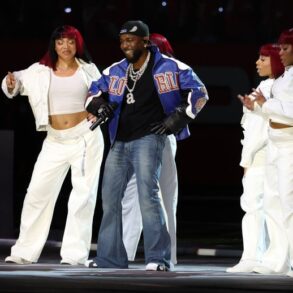Truly iconic fashion moments don’t come along that often, but at the start of the 1990s there was a succession of them. The decade began with an era-defining British Vogue cover, shot by Peter Lindbergh, and featuring Cindy Crawford, Naomi Campbell, Tatjana Patitz, Linda Evangelista and Christy Turlington – the most in-demand models of the time, photographed on the streets of New York in Levi’s and bodysuits.
That was soon followed by George Michael’s Freedom ’90 video – directed by David Fincher and starring the same five women – a cultural touchstone still reverberating decades later. It was such a hit – played in heavy rotation on the then-dominant MTV – that in March 1991 Gianni Versace sent four of the models down the runway to its soundtrack. If you want to know what a supermodel is, take a look at those women strutting arm-in-arm down the catwalk; glamour, confidence, power and money bouncing off them.
More like this:
– The world’s first supermodel
– Why the rock-goddess look lives on
– How the ‘naked’ look took over fashion
“You get those sudden moments in history and in fashion where everything solidifies and is defined by an image,” says Anne-Marie Curtis, former editor of Elle and founder of The Calendar Magazine, who started her career in the early 90s. One of her first assignments was to track down the supermodels for an interview. “These weren’t just models, they were pop stars.”
Fashion is a famously fickle industry. But three decades later, the four women from that Versace show are still in demand, fronting ad campaigns and landing magazine covers – namely, this September’s editions of both British and US Vogue, which reunites the original supermodels – minus Patitz, who died earlier this year – for the first time since that seminal 1990 cover. Their reunion is largely thanks to a new four-part documentary series on Apple TV+, The Super Models, which tracks the women’s trajectory from (not so) plain old models to global superstars. “These women’s lives were extraordinary,” says Roger Ross Williams, one of the show’s directors. “The supermodel term is now thrown around very loosely, but these four are really the originals.”
Becoming supermodels
While the early 90s saw the supermodels peak in terms of hype, coverage and earnings, their rise began in the mid-80s. Christy and Cindy were each spotted by photographers as teenagers in their hometowns – Christy in Walnut Creek, California; Cindy in DeKalb, Illinois. Naomi was scouted after school in London’s Covent Garden. Linda, from Ontario, Canada, got her break at the Miss Teen Niagara beauty pageant, from which she was introduced to notorious model agent John Casablancas. Their careers took off at varying rates, but they were soon regularly crossing paths. Christy and Naomi became friends, sharing an apartment in New York. When Linda joined the gang they were christened “The Trinity” by photographer Steven Meisel.
In 1987 Sarah Doukas started Storm Model Management with her brother Simon Chambers (a year later she would spot a 14-year-old Kate Moss walking through JFK airport). Before that she had worked for IMG models. She could sense a seismic shift in the industry. “It was absolutely at that pivotal moment when those girls really came to the fore,” she tells BBC Culture. “It was a real boom time, you could feel it. It was super-exciting and very glamorous.”
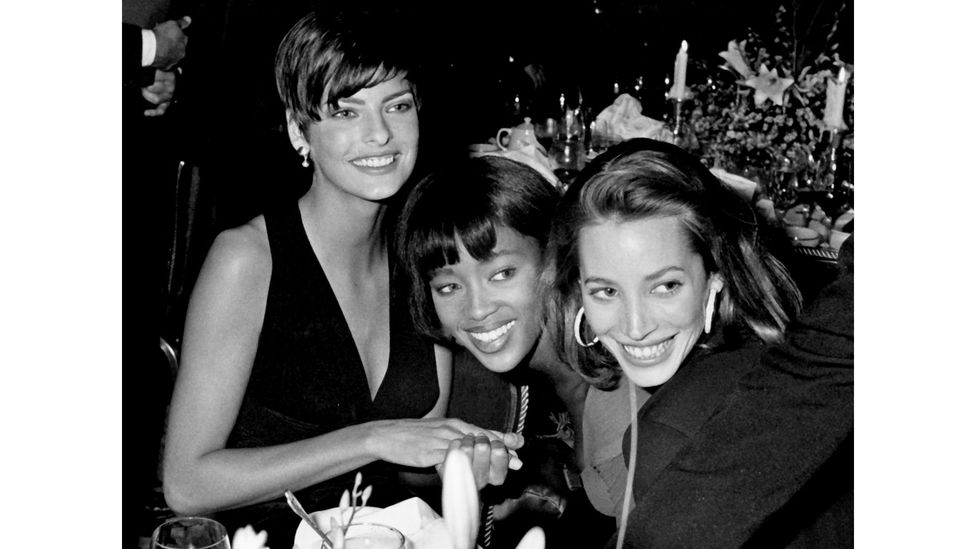
It was a time of big hair, big shoulder pads and big budgets, with the fashion industry becoming increasingly global. “Luxury brands were suddenly marketing internationally, so when these girls were the face of a campaign, they were recognised all over the world,” says Chambers. There had been famous models before – Twiggy, Jerry Hall, Verushka, Gia – but largely, models were anonymous. “Models didn’t get credited at all,” says Doukas. Now though, people wanted to know who these women were.
Each girl had her own selling point. Christy was the classic beauty; Cindy the all-American girl; Linda the chameleon; Naomi the natural mover (she was a trained dancer). “They were all different and that made them almost like a girl band,” says Chambers. Their close bond only added to the appeal. “These girls became great friends and they made great friends with their clients,” says Doukas. “It was like an amazing club.” They worked hard, too. “Mommy and Daddy weren’t bailing me out,” says Cindy. “There wasn’t that cushion, which gave me a lot of drive. I hustled.”
The women were just one piece of the puzzle, though. Their rise coincided with a golden age of fashion photography. “Vogue had the best photographers in the world shooting, and these photographers only wanted to work with these girls,” says Doukas.




Cindy Crawford pictured in 1994 – each woman had their own selling-point, and Cindy was the all-American beauty (Credit: Getty Images)
Christy says “everything changed” when she met Arthur Elgort, aged 16. Cindy says of Richard Avedon: “He taught me how to bring it.” Peter Lindbergh convinced Linda to cut off her hair in 1988 – which led to her landing her first Vogue cover. Then there was Steven Meisel, whose studio on New York’s 23rd Street was nicknamed “the clinic” because girls went in models, and came out superstars. “He moulds you in such a subtle way that you’re almost like, ‘how did he get that out of me because I didn’t know I had it in me,'” says Naomi.
The women were close with the designers too. Azzedine Alaïa took a teenage Naomi under his wing –she called him “Papa” and lived in his Paris home for a while. “I would sneak out the window to go clubbing… he’d come down to the nightclub and before he took me home he’d tell me ‘you’re wearing the outfit wrong.'”
When Naomi told Yves Saint Laurent she wanted to be on the cover of French Vogue – a black model never had been – he helped make it happen. Campbell also became the first black model to appear on the front cover of Time, British Vogue and the September issue of American Vogue – achievements she had to fight much harder for than her peers. “I wanted what the white model was getting,” she says. “I wanted it too.”
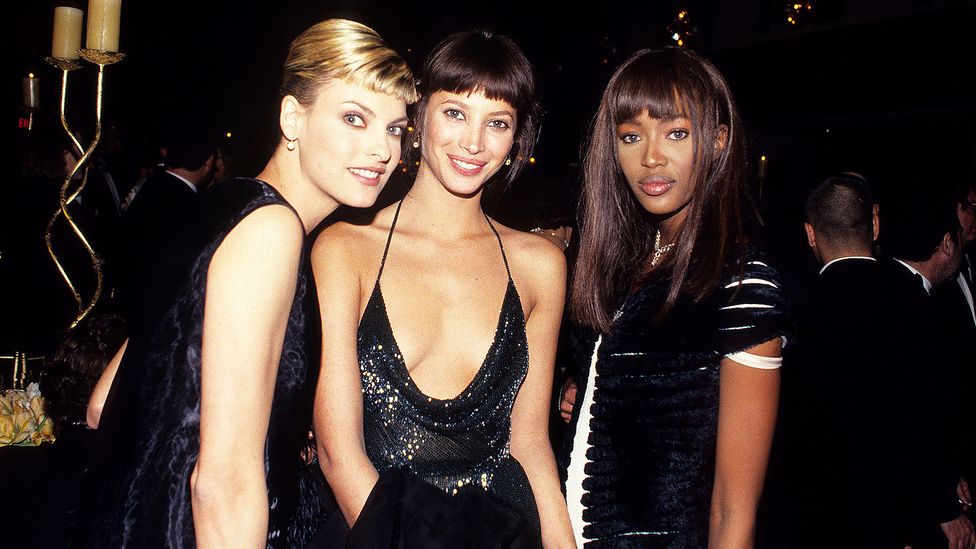



Linda Evangelista, Christy Turlington and Naomi Campbell pictured in 1994 (Credit: Getty Images)
The others told Naomi what they made – and urged her not to accept anything less. Linda started refusing to appear at shows unless they booked Naomi too. When she did walk, it was mesmerising. “Nobody walked like Naomi. She had a walk that basically said: ‘get the fuck out of my way’,” says Hal Rubenstein, co-founder of InStyle.
Anne-Marie Curtis remembers how commanding the models were at shows. “When one of those girls would walk out, the paparazzi would go absolutely nuts,” she says. “It felt really electrifying being in their presence. Naomi and Linda especially, absolutely owned the catwalk. They really were extraordinary.”
Model behaviour
The women were well aware of their power – as demonstrated by Linda Evangelista’s now infamous quip to Vogue magazine: “We don’t wake up for less than $10,000 a day.” That was probably a conservative figure. Aged 20, Christy signed a seven-figure deal with Calvin Klein. Cindy had a lucrative multi-year contract with Revlon. Linda signed a record $5m deal with Clairol. “Brands knew that these girls sold their clothes, makeup, jewellery, watches, whatever it was they were selling,” says Doukas. “They could afford to use them, and so why not? The girls guaranteed attention and prestige.”
Cindy veered away from high fashion, posing for Playboy, releasing a workout video and presenting MTV’s House of Style. Naomi published a now-forgotten novel. “It completely transcended the fashion orbit in that they became really recognisable household names,” says Curtis. “There are very few models who the general public can identify. My mum would know who Naomi Campbell was.”
While these women – and others, like Helena Christensen, Stephanie Seymour and Claudia Schiffer – had the world at their feet, things weren’t great for everyone. “There was a lot of behaviour in the industry that wouldn’t be allowed now,” says Curtis.
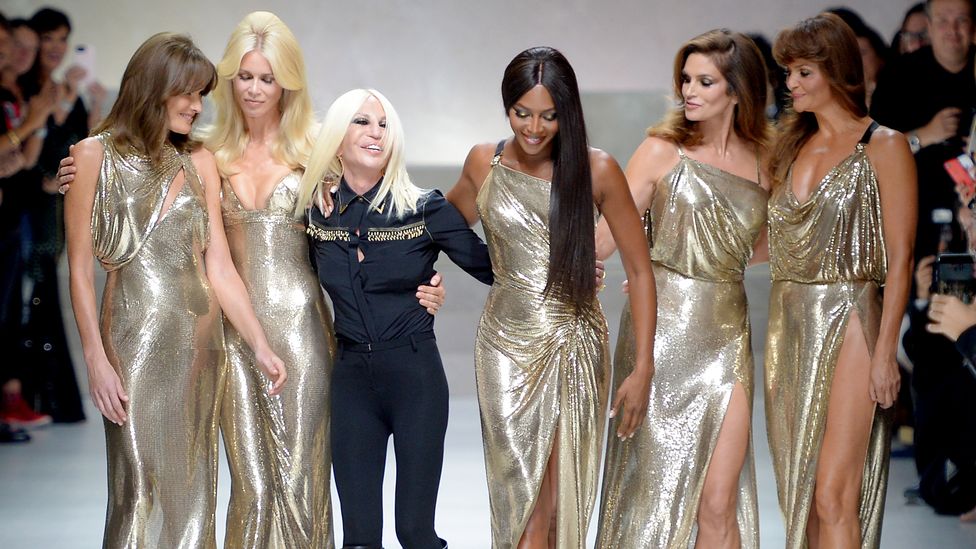



The supermodels, along with Claudia Schiffer and Helena Christensen, became household names (Credit: Getty Images)
Some of the big modelling agents of the time would go on to face allegations of sexual assault. Jean-Luc Brunel, head of Turlington’s agency, Karin Models (and a known associate of Jeffrey Epstein) was awaiting trial for allegations of sexual assault, rape and sex trafficking when he was found dead in prison in 2022. Several women made allegations of sexual assault and rape against Gérald Marie, European head of Elite Models – and Evangelista’s ex-husband, which he denied. In 2023, prosecutors announced they had closed the investigation on the grounds of statute of limitations. Evangelista publicly supported Marie’s accusers, and in the documentary she hints at what went on in their own relationship. (“He knew not to touch my face… the money maker”.)
By the mid-90s, Kate Moss had muscled in on the scene. “That was a huge shift in that she looked more raw and accessible,” says Doukas, Moss’s agent for 28 years. “She was beautiful and real, and people felt they could relate to her. She was still a supermodel, and those girls were her friends. She just became the new girl on the block.”
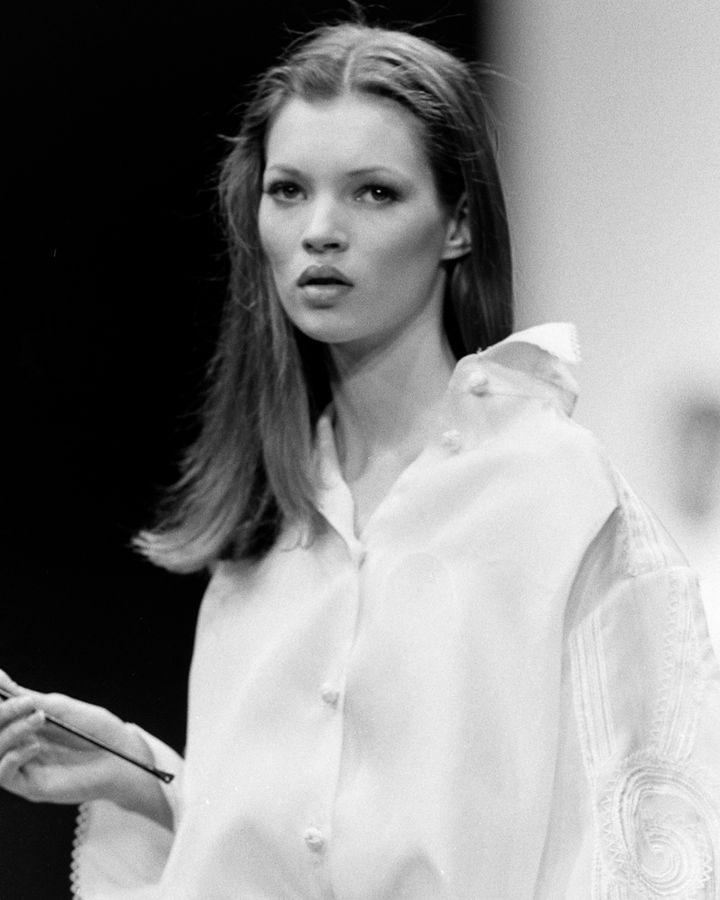



By the mid-90s, the waif-like, grungy beauty of Kate Moss had arrived on the scene (Credit: Getty Images)
There was plenty of crossover, but the influence of grunge on fashion signalled a rejection of glossy perfection, and designers started favouring more androgynous, waif-like models. In the years that followed, there were new stars – Amber Valetta, Giselle, Heidi Klum – but none ever quite captured the public imagination in the same way. By the late 90s, Vogue had started putting celebrities on the cover instead.
A unique moment
Yet over the decades, the original four supermodels continued to be in demand. “They have managed to maintain their relevance,” says Curtis. “In fashion – which is all about change – it’s an extraordinarily long time to be able to do that.”
Linda did disappear from the spotlight for several years – revealing in 2022 that a non-invasive fat-freezing procedure had left her “permanently deformed” and “brutally disfigured”. They’re strong words – until you remember the industry she is operating within. One of the most revealing moments in the TV show is when a tearful Evangelista explains why she had the procedure: “I wanted to like what I saw in the mirror,” she explains, adding: “I wish we could really see ourselves in the mirror, non-distorted, without ever having seen ourselves with a filter, or retouched.”
The September 2022 cover of British Vogue saw Evangelista’s jaw and neck taped back and her head wrapped in a scarf (the model was open about it, saying: “Look, for photos I always think we’re here to create fantasies“). It was hailed as a triumphant return, but felt more like a depressing reminder of the impossible beauty standards imposed on women. This September’s Vogue shoot, in which the four women – all in their 50s – have aggressively smooth faces, has also drawn criticism. It feels like a missed opportunity, especially when the TV series itself captures the women backstage looking far more “real”.
Yet, blame it on nostalgia, you can’t deny the pleasure at seeing the supermodels back together – still powerful, still friends, still adored. “People still want to read about them, they’re referenced on mood boards and designers are inspired by them,” says Curtis.
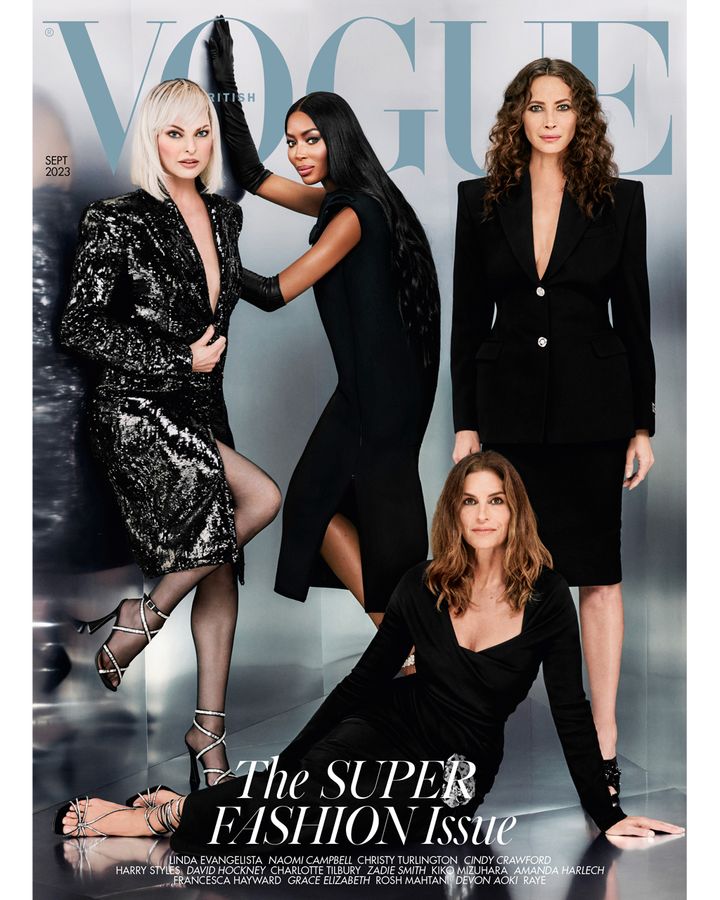



The original four supermodels continue to be in demand; in September 2023 they were pictured on the covers of US and British Vogue (Credit: Rafael Pavarotti for Vogue)
Part of it is the knowledge that we’ll probably never see their like again. “Models aren’t as famous anymore,” says Doukas, “The industry has developed into something different. Brands now want to use girls that have a large social media following. Advertising agencies have pretty much gone to the wall and people just cut straight to the chase. It’s extraordinary, the power of people like Kendall [Jenner] and Gigi and Bella [Hadid], and these big social media stars. They sell products. Everybody buys what they have.”
Unlike the original supermodels, whose careers gave them a lifestyle they could only otherwise have dreamt of, today’s biggest faces are often already rich and famous. Some of them are even children of supermodels – like Cindy’s daughter Kaia and Kate Moss’s daughter Lila.
“The people wearing and marketing fashion now are so diverse, whether they’re influencers, models, actresses… whoever. It’s spread all over the place,” says Chambers. Storm launched Vision, an arm dedicated to content creators, 13 years ago. “We’ve tried to stay ahead and embrace this new digital world because everything evolves,” says Doukas. They still scout (Doukas recently spotted a girl in the choir at the King’s coronation), but the chance of a new face ever reaching the dizzy heights of Cindy, Naomi, Linda and Christy is slim.
“Unless something extraordinary happened, I don’t think that I could find someone like Kate in JFK or Christie in San Francisco, or Naomi in London, and make them as famous as that now. It would be nearly impossible.”
The Super Models premieres on Apple TV+ on 20 September.
If you liked this story, sign up for the weekly bbc.com features newsletter, called The Essential List. A handpicked selection of stories from BBC Future, Culture, Worklife and Travel, delivered to your inbox every Friday.
If you would like to comment on this story or anything else you have seen on BBC Culture, head over to our Facebook page or message us on Twitter.
This post was originally published on this site be sure to check out more of their content.





